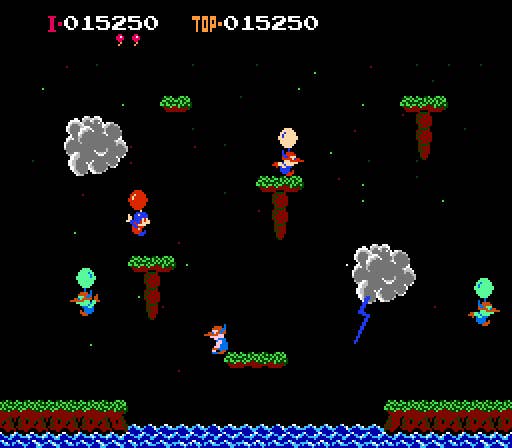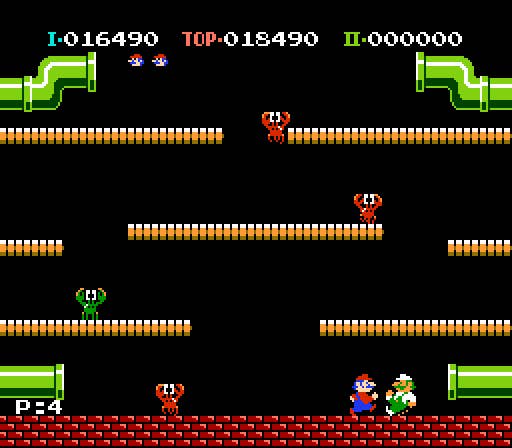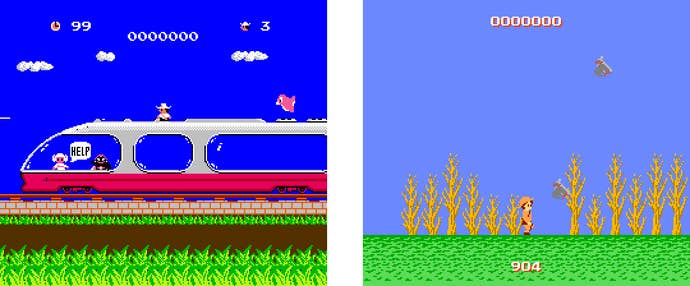NES Creator Masayuki Uemura on the Birth of Nintendo's First Console
The man who designed Nintendo's revolutionary console recounts the system's birth and the challenges of building an international business.
This article first appeared on USgamer, a partner publication of VG247. Some content, such as this article, has been migrated to VG247 for posterity after USgamer's closure - but it has not been edited or further vetted by the VG247 team.

Aiming for the sky
The high bar to which Famicom hardware aspired—a home console capable of reproducing a cutting-edge arcade board in an interchangeable cartridge format—necessitated a number of small but crucial compromises. Perhaps the greatest challenge arose from the fact that Yamauchi imposed a strict price limit on the final hardware: Not only did it need to sell below a firm price point, low enough to give it mass-market appeal for a young audience, it also needed to turn a profit at that price.
Uemura's task, then, became almost a puzzle: Which components would be essential? Which could be removed without compromising the crucial capabilities of the system.
"One thing that I was left to decide on my own was, 'Where will I draw the line on sacrificing cost for the inclusion of functionality?' or, 'Where will we allow the cost to rise a bit? Is this something we can’t do without, even if the cost does go up a bit?'"
This sort of ruthless culling has always been a key component of Nintendo's hardware business. Certainly the competition has made use of it as well, though less consistently, and the resistance that more expensive console launches through the years have faced (including PlayStation 3 and Xbox One) bears out the wisdom of the reductive approach. But as Uemura notes, the Nintendo way isn't simply to whittle down a hardware spec to the bare minimum; rather, a key element of this strategy involves knowing when not to cut features, or even to add a more expensive option into the mix.
"One concrete example of this is that the Famicom uses two ROM [fixed, read-only memory] chips," he says. "That's one aspect that caused the cost of the system to go up."

Anyone who has ever seriously tinkered with NES games, whether hacking ROMs or even just emulating them, has likely noticed that the cartridges come broken into two pieces: CHR-ROM, where character and graphical data is stored, and PRG-ROM, where commands and programs exist. In fact, this turned out to be a key element of the system's longevity: The console could support much bigger games than would actually fit into its meager onboard RAM capacity by "paging" between different ROM files. Something like Kirby's Adventure greatly exceeded the console's built-in memory, but the dual-format approach Uemura implemented made such massive games possible—another serendipitous event that resulted from a cost-cutting measure.
"The common thinking at the time was, 'Systems like this will include just one ROM chip,'" he recalls. "But in looking into it, I realized that we could save costs by using two ROM chips.
"One thing connected to this was the spread and popularization of word processors in Japan at this time as well. Because of the popularization of word processors and the requirement that they have of being able to produce kanji [the complex Chinese pictograms used for writing Japanese text] with these ROM chips, there were tons of ROM chips being produced in Japan at this time.
"The high demand for personal computers made RAM more expensive at the time, which made ROM chips a more economical decision.
"One of the biggest reasons for this is that with games, you’re not creating data yourself—you’re using data created by someone else—so you don’t need RAM as much as you can actually make use of ROM. But with personal computers, it’s the opposite, in that you need RAM in order to create data. We designed the hardware from the beginning with the understanding that it would be modular, via the memory mapping chips, so that was intentional from the beginning."

In other words, the decision to make dual-format ROM cartridges meant the console could get by with less RAM, and carts didn't need to include any expensive, onboard RAM. While the increased complexity involved in supporting this format may have raised the price of the console itself, it made for cheaper carts that could grow in size and capabilities as the platform and its software matured.
Similarly, the Famicom team chose to invest considerable resources into the system's audio chip. At the time, he says, "everything was beeps and boops, because you can't hear anything in an arcade anyway." But playing at home, away from the cacophony of the arcade, meant that such simple, repetitive sounds would soon grow irritating. Handily, Uemura says that one of the engineers on his team loved to play piano and was able to bring that expertise to bear on the audio chip.
The Famicom's arrival meant Nintendo had begun to grow in a serious way, and Uemura quickly found himself in the thick of things.
"This meant that now there were teams making arcade games, making the Game & Watch, and making what ended up becoming the Famicom—the home console," he says. "I ended up having some role in all three of those. We had relatively a lot of people at Nintendo at that time who were knowledgeable about specific types of technology, but because I had done some work in each of these groups now, and I’d also—in the previous consoles we’d made—needed to have relationships with semiconductor producers, this kind of put me in the position that made me have a bit of an advantage in designing a system like the Famicom.
"We had to keep our team small, but I think we had the right people on it. So for example, we had Mr. Miyamoto, and one of the decisions that was the most important at the time he was involved in making was, 'What types of colors will we use on the screen that are going to be the most effective?', 'What colors should we use that will communicate well to the player?'—things like that.




Strength in failure
"In one sense, Nintendo was similar to Atari, but we also had this history of having been a toy maker," Uemura says. "Basically, and we made all of those toys in-house, and I think if you looked around the world at that time, we had kind of a unique history entering the video game console market. Another thing that I think was characteristic of our company at the time—and still is today—is an insistence on quality, and that had been something we had been really careful with and insistent on for our toys, but we were really sensitive to the quality of things that we were going to produce."
That demand for quality would find itself put to the test shortly after the 1983 launch of the Famicom. The initial batch of consoles turned out to have a minor defect that would cause certain games to fail. Some estimates peg this as a less than 1% failure rate, yet Nintendo chose to recall those early systems at considerable cost to themselves. This had the side effect of making early Famicom units—recognizable by the square-shaped buttons on their controllers—rare and valuable; more importantly, though, it demonstrated the company's commitment to doing right by its customers. Rather than demolish the company, the early Famicom recall improved Nintendo's standing in customers' eyes and helped spur the first big wave of hardware and software sales.
"Even as far back as the hanafuda cards we made [in the 19th century], we were really careful with the quality of them, and so something—even if it had the slightest imperfection or a stain on the card would immediately be discarded as no good. So even though this was a new technology we were embarking on, we had that past as a maker concerned with quality and with making everything in-house that we brought to this new endeavor."
"One of the greatest things about systems like this was that we were excited about making something new, but then we turned that over to people making the games for it. They took up this challenge of, 'Well, I’m going to do these things that were never conceived of by the creator of the system,' and I was really thrilled to see things like that."
Nintendo still couldn't iron every single imperfection out of the hardware, and in fact Uemura has a certain fondness for some of the minor quirks of the NES, which he feels give it character.
"The Famicom was designed from the start using the hardware’s technology to be able to do horizontal scrolling like you’d see in a Super Mario Bros. game. But one of the things that surprised me that I didn’t expect was... well, if you think about the game F-Zero for the Super Nintendo as an example, something that people creating games for the Famicom eventually discovered was the ability to have scrolling that didn’t involve the entire screen, but single horizontal lines could be moved, independently, horizontally. In Super NES games like F-Zero, you see that with the shifting tracks and things like that.
"In a way, this is actually kind of a bug, that because it’s something in the design phase that we didn’t realize could be done, and it was exploited by people making games later. But I think that’s actually one of the greatest things about systems like this was that we were excited about making something new, but then we turned that over to people making the games for it. They took up this challenge of, 'Well, I’m going to do these things that were never conceived of by the creator of the system,' and I was really thrilled to see things like that."
Uemura feels the limitations of the system helped foster creativity. As with the Famicom's original objective—to be able to play a convincing reproduction of Donkey Kong on an inexpensive home console capable of supporting interchangeable carts—the stark restrictions of the hardware posed an enticing challenge to game designers.

"At the time, we saw when the Famicom came out there was a rush to make games for it, and we saw games coming from all types of developers. But you have to keep in mind that, at the time, most of these people were developers who had made arcade games; they had been used to making games on hardware that was specific to the game that they were designing. But you couldn't change the hardware of the Famicom itself. Once they had that realization, that, 'Oh, this is something via the chipset for the game that I’m making, I can express my individuality and discover new things'... I think that was really exciting for people who had come up through arcade development to get into making games for a home console.
"Another aspect of this same point is that, on the user’s side as well, this was one of the first times that you were able to have products that you could interact with in a way unintended by the person who made them. Now normally, with products like that, if you discover some way that it doesn’t work as intended, that means you’re getting a return, or that it’s a piece of damaged merchandise. But with games, these often were glitches or things that were actually bugs, but there were ways that the user could discover to play the game in an unintended way, in a way that was advantageous to them. And so that was another way that there was an element of discovery and newness to this mode of play."
Indeed, much of the NES's fan culture revolves around famous errors and bugs. The best-known of these is almost certainly the Minus World of Super Mario Bros., in which players can trick the game into sending them to an endless level that doesn't actually exist in game code. The vast "lost worlds" of Metroid inspired a similar obsession. And entire now communities exist around completing games in as little time as possible by exploiting glitches and programming tics to find shortcuts.
"With games being more established today, in many cases, bugs like the ones I’m talking about from that era have been ironed out of the system in a lot of ways. I think that's a bit unfortunate, because it takes a bit away from that sense of discovery. At that time, when we would bring the games to America a lot of times, we would have the time to remove some of those bugs from the time when the game first came out in Japan.
"Maybe that's something about the culture of play in Japan—the idea of getting every ounce of enjoyment out of whatever it is you’re playing. If that means finding every possible way to use whatever it is that you’re playing with, there may have been something about the joy of finding bugs and using them to your advantage.
"That's something that made me chuckle as a designer, once we knew people were doing this. It was fun to know that people were out there using this thing that we had made in these ways we hadn’t imagined. I have a feeling that this was something really important to the gaming culture, and that the kind of connectivity that people felt at the time was this discovery of bugs and stuff. The fact that has kind of disappeared from games today is something I find a bit unfortunate.
"I’m not saying that things like problems with certain games that came out for Atari systems, where the game would have a bug where it wouldn’t work—that’s not good. But as long as the game itself is working the way it’s intended, if there are fun little exploits and tricks people can find in there, that’s the type of thing I’m talking about."








